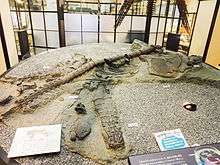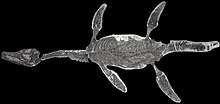Futabasaurus
Futabasaurus is a genus of plesiosaur from the Late Cretaceous of Fukushima, Japan. It was described and named in 2006, and was assigned to the family Elasmosauridae. The genus contains one species, F. suzukii.
| Futabasaurus | |
|---|---|
 | |
| Reconstructed skeleton at National Science Museum, Tokyo | |
| Scientific classification | |
| Kingdom: | Animalia |
| Phylum: | Chordata |
| Class: | Reptilia |
| Superorder: | †Sauropterygia |
| Order: | †Plesiosauria |
| Family: | †Elasmosauridae |
| Genus: | †Futabasaurus Sato, Hasegawa & Manabe, 2006 |
| Species: | †F. suzukii |
| Binomial name | |
| †Futabasaurus suzukii Sato, Hasegawa & Manabe, 2006 | |
Description

The length of Futabasaurus has been estimated at 6.4–9.2 metres (21–30 ft),[1] and it weighed about 3–4 tonnes (3.0–3.9 LT). It can be distinguished from other elasmosaurids by the following characteristics: there is a long distance between the eye sockets and nostrils; the interclavicles and clavicles are fused, and the anterior edge is bent; the humerus is relatively long; and the femora are slim and show prominent muscle scars.[2]
Discovery and naming
Futabasaurus is the first elasmosaurid found in Japan. It was originally known as either "Wellesisaurus sudzuki" or "Futaba-ryu" before publication. The type specimen of Futabasaurus was found in the Irimazawa Member of the Tamayama Formation, in the Futaba Group of Fukushima Prefecture, Japan. The rocks in which it were found date to the Inoceramus amakusensis zone of the early Santonian. The fossils were found by Tadashi Suzuki, then a high school student.[2] Many of the bones of the type specimen show signs of apparent scavenging or predation by sharks.[2]
The genus Futabasaurus was named after the Futaba Group, in which it was discovered; the species name is derived from the family name of its discoverer, Suzuki.[2] The name "Futabasaurus" has also been used for an unrelated theropod dinosaur, also from the Late Cretaceous of Japan. However, this dinosaur was not officially named, and remains a nomen nudum.
Classification
The following cladogram shows the placement of Futabasaurus within Elasmosauridae following an analysis by Rodrigo A. Otero, 2016:[3]

| Elasmosauridae |
| |||||||||||||||||||||||||||||||||||||||||||||||||||||||||||||||||||||||||||||||||||||||||||||||||||||||||
References
- O'Gorman, J.P. (2016). "A Small Body Sized Non-Aristonectine Elasmosaurid (Sauropterygia, Plesiosauria) from the Late Cretaceous of Patagonia with Comments on the Relationships of the Patagonian and Antarctic Elasmosaurids". Ameghiniana. 53 (3): 245–268. doi:10.5710/AMGH.29.11.2015.2928.
- Sato, Tamaki; Hasegawa, Yoshikazu; Manabe, Makoto (2006). "A new elasmosaurid plesiosaur from the Upper Cretaceous of Fukushima, Japan". Palaeontology. 49 (3): 467–484. doi:10.1111/j.1475-4983.2006.00554.x.
- Otero, R. A. (2016). "Taxonomic reassessment of Hydralmosaurus as Styxosaurus: new insights on the elasmosaurid neck evolution throughout the Cretaceous". PeerJ. 4: e1777. doi:10.7717/peerj.1777. PMC 4806632. PMID 27019781.
| Wikispecies has information related to Futabasaurus |
| Wikimedia Commons has media related to Futabasaurus. |





